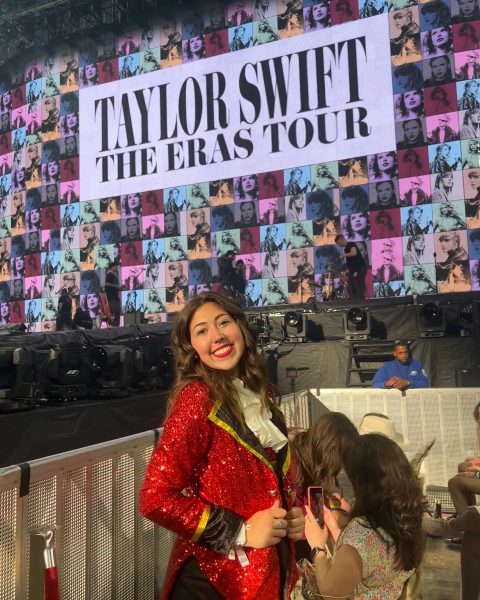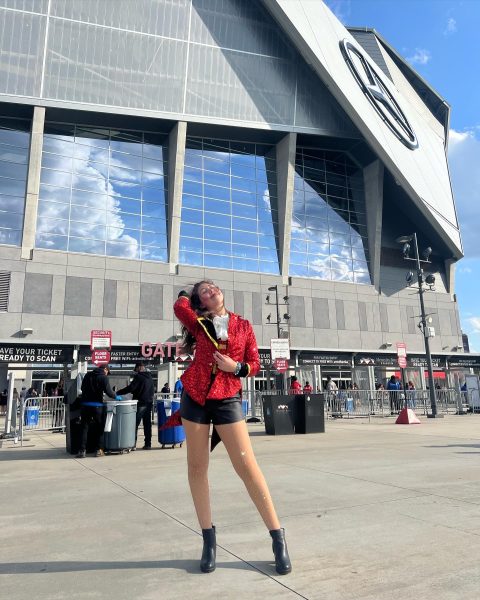

Concert attire has become a popular topic on social media platforms as a way to promote individual style and unique clothing brands.
Summer is quickly approaching, bringing warm weather, breaks from school and most importantly, concerts and music festivals.
Big-name artists like Sabrina Carpenter, Kendrick Lamar and Green Day are touring this summer.
Concert series’ and festivals like Coachella, Rolling Loud and Shaky Knees are home to some of the year’s biggest music scenes.
With the variety of artists and events happening right now, the big question for most concert goers has less to do with ticket prices, venue location or openers, instead their concerns lie with what to wear.
Taylor Swift’s “The Eras Tour” has become one of the biggest examples of prominence when discussing the topic of concert attendees’ outfit choices.
Swift held 149 concerts in 21 different countries and took the internet by storm with a movie capturing the experience, clips of different performances and importantly, fan’s outfit choices.
Most attendees’ outfit choices reflected Swift’s different albums and genres in the form of clothes.
Popular outfits included looks taken from Swift’s past music videos, tours, album covers and most specifically from songs or lyrics. Prominent features of most fans’ fits comes down to Swift’s signature “13” drawn on her hand.
The Eras Tour highlighted the significance of concert attire and became a focal point for the spread of fashion trends within an artist’s fanbase.
Everyone has their own preferences when it comes to dressing up for concerts.
Hannah Beth Chapman, a sophomore history major, recently went to and enjoyed a Hozier concert.
“I wore a pair of Mary Jane shoes, a long brown skirt, a cream tank top and then a black cardigan on top,” Chapman said.
Chapman went to the concert with friends who also liked the experience of picking out their outfits for the event.
“My friend wore a white sweater, black jeans and a cool headband,” Chapman said.
Claire Peterson, a sophomore mass communication major, attended the local Milledgeville concert series, Sounds of the Spring, recently.
“I ended up wearing this little black tank top with a dark denim mini skirt, and then I had this long, loose knit sweater that I tied,” Peterson said. “I thrifted it a couple of years ago.”
Peterson highlighted the universal experience of getting ready as a pivotal step that every concert attendee takes.
“It actually took me quite a bit of time to pick out my outfit,” Peterson said. “My roommates and I played dress up a lot.”
Ty Karraker, a junior mass communication major, has been to a number of concerts in Milledgeville and Atlanta within recent months.
“I honestly think that there’s less of an expectation for guys to dress up for concerts,” Karraker said. “In Milledgeville especially, the majority of guys wear jeans and a t-shirt or a polo; that’s what I usually wear too.”
Apart from personal style, different music genres can be defining features in determining how one dresses to attend a concert.
Chapman could see common themes in the crowd’s choice of clothing at the Hozier concert.
“People were wearing a lot of long skirts, Converse and boots,” Chapman said. “There were a lot of warm tones and white and brown clothes; it was very cottage-core.”
Hozier is an Irish musician famous for his mix of indie, folk and alternative genres within his music.
“I’d say Hozier’s specific genre of music was reflected in what people were wearing,” Chapman said.
Sounds of the Spring was a series of concerts held throughout downtown Milledgeville in March.
“There were some people that were wearing normal going-out outfits, like a nice top and jeans,” Peterson said. “Then there were a lot of people who dressed up a little more, like dresses, tights, a lot of jewelry, everything like that.”
At each specific show, attendees’ outfits became reflective of the specific genres being played. Many of these genres fall into their own subcultures, which generally reflect specific fashion trends.
“There were a couple different bands that were playing different genres,” Peterson said. “The bands playing at Blackbird were more of punk or grunge, so people that were there were dressing more to that subculture.”
Smaller concerts, like those held in Milledgeville and other college towns, have a unique atmosphere compared to major concerts held in arenas or big cities.
“I feel like to an extent, there’s a dress code for college concerts, especially here,” Peterson said. “It’s kind of a little bit more alternative and a little bit more edgy in some ways.”
Today, social media plays a large role in concert attire, from “get ready with me” videos, brand promotion or sharing pictures of the events on different platforms, social media has become an integral part of the concert experience.
In terms of personal style, social media can be a useful tool for picking out outfits.
“I’ve definitely seen posts about what people are wearing to go to concerts,” Karraker said. “I think it’s cool to see how creative they get with it.”
Social media also spreads inspiration for unique topics and helps introduce people to new things.
“Social media opens you up to a variety of subcultures and aesthetics and can give you a lot of good ideas on what to wear,” Chapman said.
Social media can have its downsides when it comes to trends and promoting certain clothing styles at concerts and festivals.
“You sometimes see posts about concerts, and everyone in the crowd is wearing the same thing,” Karraker said. “So I think it can go either way with how social media plays a role in what people wear to concerts.”
Social media is a useful source of inspiration, but it can have an impact on how quickly people buy certain items of clothing and trends.
“I think social media creates more consumerism and buying things you may not really need,” Chapman said. “People might buy a piece of clothing to wear for a concert and then never wear it again.”
For many, picking out what to wear is an important part of the concert experience.
Based on the artist’s fan-base or subculture surrounding a band’s music, concert attendees can find inspiration in what to wear.
While social media can impact how people dress for concerts, there is a balance of inspiration and creativity that attendees can utilize when making their outfit decisions.
Ultimately, whether an attendee chooses to dress up or stay casual, to reflect a genre or dress in one’s own personal style, it comes down to individual preference; there is no real dress code for concert attire.

